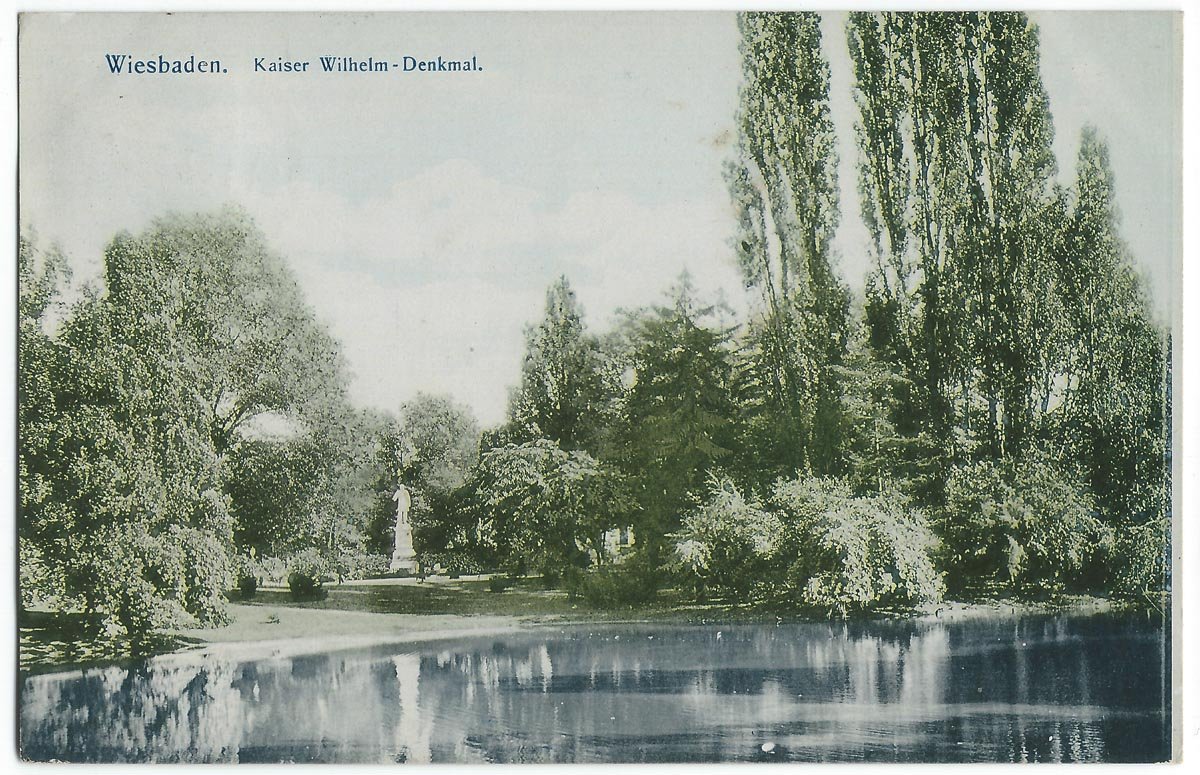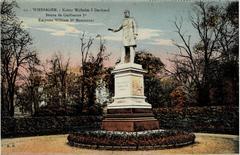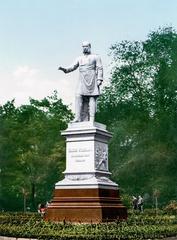
Kaiser Wilhelm Denkmal Wiesbaden: Visiting Hours, Tickets, and Historical Information
Date: 14/06/2025
Introduction
The Kaiser Wilhelm Denkmal in Wiesbaden, Germany, is not only an iconic symbol of imperial history but also a testament to the city’s rich cultural and religious heritage. Featuring several monuments across Wiesbaden—including the prominent statues at Marktkirche square, Neroberg hill, and Schläferskopf hill—these sites celebrate figures such as William of Orange and Kaiser Wilhelm I. Together, they reflect Germany’s and the Netherlands’ intertwined histories, Wiesbaden’s Protestant roots, and the city’s reputation as a spa and cultural hub. Whether you are a history enthusiast, architecture admirer, or traveler seeking panoramic views, a visit to these monuments offers a unique window into the past and present of Wiesbaden.
For up-to-date visitor information and historical context, consult sources such as wiesbaden.de, Dead Emperors Society, and German Sights.
Contents
- Introduction
- Historical Origins and Commissioning
- William of Orange and Kaiser Wilhelm I: Figures Behind the Monuments
- Political, Cultural, and Artistic Context
- Monument Locations and Features
- Visiting Information
- Location and Address
- Hours and Tickets
- Accessibility
- Tours and Events
- Nearby Attractions
- Travel Tips
- Preservation and Contemporary Significance
- FAQ
- Conclusion
- References
Historical Origins and Commissioning
The Kaiser Wilhelm monuments in Wiesbaden were inaugurated in the late 19th and early 20th centuries. The Marktkirche monument, gifted by Kaiser Wilhelm II and unveiled in 1908, honors William of Orange (“The Silent”), a foundational leader in the Dutch revolt against Spanish rule. The choice of location was determined through public debate, with Kaiser Wilhelm II ultimately selecting the square in front of the prominent red-brick Marktkirche, emphasizing the city’s Protestant and civic identity (wiesbaden.de).
The Neroberg and Schläferskopf monuments were erected to commemorate Emperor Wilhelm I, Germany’s first emperor and a unifier of the German states. These sites were strategically placed for their commanding views and symbolic oversight of the city, reinforcing Wiesbaden’s status as a spa town frequented by European nobility (German Sights).
William of Orange and Kaiser Wilhelm I: Figures Behind the Monuments
- William of Orange (1533–1584): Known as “The Silent,” he was a key figure in the Dutch struggle for independence. His legacy is commemorated as a symbol of Protestant faith, religious tolerance, and steadfast resistance. The statue’s Latin motto, “Saevis tranquillus in undis” (“Calm in the midst of the storm”), embodies his enduring influence (wiesbaden.de).
- Kaiser Wilhelm I (1797–1888): As the first Emperor of unified Germany, Wilhelm I’s monuments in Wiesbaden reflect both imperial unity and local civic pride. His regular visits to Wiesbaden’s spas and the city’s embrace of his legacy are evident in the monument’s prominence and design (German Sights; Wikipedia: Emperor William monuments).
Political, Cultural, and Artistic Context
Commissioned during a period of burgeoning German national identity, these monuments balance imperial grandeur with local character. The statue of William of Orange highlights Protestant resistance and German-Dutch ties, while the Kaiser Wilhelm I monuments focus on unity and the healing traditions of Wiesbaden’s spa culture. Funded largely by local citizens, these monuments are expressions of civic pride and religious tolerance (Dead Emperors Society).
Artistic Features
- Marktkirche Monument: Bronze statue of William of Orange in a reflective pose, set against the striking red-brick Marktkirche.
- Neroberg Monument: Features a bronze figure of Kaiser Wilhelm I atop a substantial stone pedestal, with reliefs illustrating moments from his reign.
- Schläferskopf Tower: Constructed from local quartzite and basalt, this historicist tower features twin spiral staircases and a grand Kaisersaal, reflecting medieval motifs and urban ambition (wiesbaden-lebt.de).
Monument Locations and Features
Marktkirche Square
- Address: Marktplatz, 65183 Wiesbaden, Germany
- Notable for: Statue of William of Orange; proximity to the iconic Marktkirche.
Neroberg Hill
- Features: Bronze statue of Kaiser Wilhelm I; panoramic city and Rhine Valley views; accessible via the historic Nerobergbahn funicular (German Sights: Neroberg).
Schläferskopf Hill
- Features: Kaiser Wilhelm Tower (Kaiser-Wilhelm-Turm); observation platform; scenic hiking and cycling trails; Kaisersaal open during special events (wiesbaden-lebt.de).
Visiting Information
Location and Access
- Marktkirche Monument: Public square in the city center, adjacent to Wiesbaden’s main Protestant church.
- Neroberg Monument: Reached via Nerobergbahn funicular (operates approximately 10:00 AM–6:00 PM, late March–early November).
- Schläferskopf Tower: Accessible by hiking/cycling trails; check for event-specific opening times.
Opening Hours
- Marktkirche and Neroberg Monuments: Open year-round, 24/7, as outdoor public sites.
- Schläferskopf Tower: Open primarily during special events (e.g., European Heritage Days). Check official sources for current schedules (wiesbaden.de).
Entry and Tickets
- Marktkirche and Neroberg: Free to visit.
- Nerobergbahn Funicular: Ticket required (€3.50 round-trip, discounts available).
- Schläferskopf Tower: Access during events may be free or ticketed; verify in advance.
Accessibility
- Marktkirche Area: Wheelchair accessible with paved walkways.
- Neroberg: Generally accessible via funicular, though some paths may be uneven.
- Schläferskopf: Limited accessibility due to spiral staircases; inquire ahead for accommodations.
Guided Tours and Events
- Guided walking tours of Wiesbaden’s historic center often include the Marktkirche and Neroberg monuments.
- Special events and guided tours at Schläferskopf are held during European Heritage Days and other occasions.
- For schedules, consult the official Wiesbaden tourism website or local tourist offices.
Nearby Attractions
- Marktkirche
- Wiesbaden City Palace (Stadtschloss)
- Kurhaus and Kurpark
- Russian Orthodox Church of Saint Elizabeth
- Opelbad (open-air pool at Neroberg)
- Hessisches Staatstheater
Travel Tips
- Visit early in the morning or late afternoon for the best lighting and smaller crowds.
- Comfortable walking shoes are recommended, especially for Neroberg and Schläferskopf.
- Consider downloading the Audiala app for interactive audio guides and up-to-date information.
Preservation and Contemporary Significance
The Kaiser Wilhelm monuments continue to be well-maintained and integrated into Wiesbaden’s urban and natural landscapes. Restoration efforts—such as those at Schläferskopf—focus on preserving both structural integrity and historical authenticity. Today, these sites function as focal points for community events, educational programs, and cultural tourism, underscoring their ongoing relevance to Wiesbaden’s identity (wiesbaden-lebt.de; wiesbaden.de).
Frequently Asked Questions (FAQ)
Q: What are the visiting hours for the Kaiser Wilhelm Denkmal monuments?
A: Outdoor monuments at Marktkirche and Neroberg are accessible 24/7. Schläferskopf Tower is open during special events; check official listings for details.
Q: Is there an entrance fee?
A: No fee for the monuments themselves. The Nerobergbahn funicular requires a ticket for access to Neroberg.
Q: Are guided tours available?
A: Yes, guided tours of Wiesbaden’s historic center and special event tours at Schläferskopf are available. Consult the Wiesbaden tourist office for current offerings.
Q: Is the site wheelchair accessible?
A: Marktkirche and Neroberg are generally accessible, while Schläferskopf has limited accessibility due to staircases.
Q: What are some nearby attractions?
A: Marktkirche, Kurhaus, Kurpark, Russian Orthodox Church, Opelbad, and the Wiesbaden City Palace.
Conclusion
The Kaiser Wilhelm Denkmal monuments are central to Wiesbaden’s historical and cultural narrative. They honor leaders who shaped European history while offering visitors a window into the city’s imperial, religious, and spa traditions. Easily accessible, free to visit, and surrounded by other cultural gems, these monuments are must-sees for anyone exploring Wiesbaden. For the most current visiting information, guided tours, and events, rely on official tourism websites and the Audiala app for an enriched, immersive experience.
References
- Kaiser Wilhelm Denkmal Wiesbaden: History, Visiting Information & Cultural Significance, Wiesbaden.de
- Tag des offenen Denkmals mit Kaiser Wilhelm Turm, Wiesbaden-lebt.de
- Kaiser-Wilhelm-Denkmal, Wiesbaden City Lexicon
- Emperor William monuments, Wikipedia
- Wiesbaden: Historical Sites and Monuments, German Sights
- German National Memorials: Weird Wonders of the Wilhelmine World, Dead Emperors Society













































































